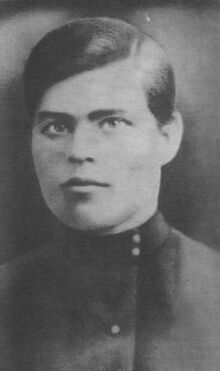Nestor Ivanovych Makhno or Bat'ko ("Father") Makhno (Ukrainian: Нестор Іванович Махно, Russian: Не́стор Ива́нович Махно́) was a Ukrainian anarcho-communist revolutionary and the commander of an independent anarchist army in Ukraine during the Russian Civil War.
As commander of the Revolutionary Insurrectionary Army of Ukraine, more commonly referred to as the Makhnovshchina or Black Army, Makhno led a guerrilla campaign during the Russian Civil War. He is also credited as the inventor of the tachanka, a horse-drawn platform mounting a heavy machine gun.
Early Years[]

Nestor Makhno, circa 1906.
Nestor Makhno was born into a poor peasant family in Huliaipole, Yekaterinoslav Governorate of the Russian Empire. He was the youngest of five children. Church files show a baptism date of November 8, 1888; but Nestor Makhno's parents registered his date of birth as 1889 (in an attempt to postpone conscription).
His father died when he was ten months old. Due to extreme poverty, he had to work as a shepherd at the age of seven. He studied at the Second Huliaipole primary school in winter at the age of eight and worked for local landlords during the summer. He left school at the age of twelve and was employed as a farmhand on the estates of nobles and on the farms of wealthy peasants or kulaks.
At the age of seventeen, he was employed in Huliaipole itself as an apprentice painter, then as a worker in a local iron foundry and ultimately as a foundryman in the same organization. During this time he became involved in revolutionary politics. His involvement was based on his experiences of injustice at work and the terrorism of the czarist regime during the Revolution of 1905. In 1906, Makhno joined the anarchist organization in Huliaipole. He was arrested in 1906, tried, and acquitted. He was again arrested in 1907, but could not be incriminated, and the charges were dropped. The third arrest came in 1908 when an infiltrator was able to testify against Makhno. In 1910, Makhno was sentenced to death by hanging, but the sentence was commuted to life imprisonment and he was sent to Butyrskaya prison in Moscow. In prison, he came under the influence of his intellectual cellmate Piotr Arshinov. He was released from prison after the February Revolution in 1917.
Organizing the Peasants' Movement[]

Nestor Makhno, circa 1918.
After liberation from prison, Makhno organized a peasants' union. It gave him a "Robin Hood" image and he expropriated large estates from landowners and distributed the land among the peasants.
In March 1918 the new Bolshevik government in Russia signed the Treaty of Brest-Litovsk concluding peace with the Central Powers, but ceding large amounts of territory, including Ukraine. As the Central Rada of the Ukrainian People's Republic (UNR) proved unable to maintain order, a coup by former Tsarist general Pavlo Skoropadsky in April 1918 resulted in the establishment of the Hetmanate. Already dissatisfied by the UNR's failure to resolve the question of land ownership, much of the peasantry refused to support a conservative government administered by former imperial officials and supported by the Austro-Hungarian and German occupiers.
